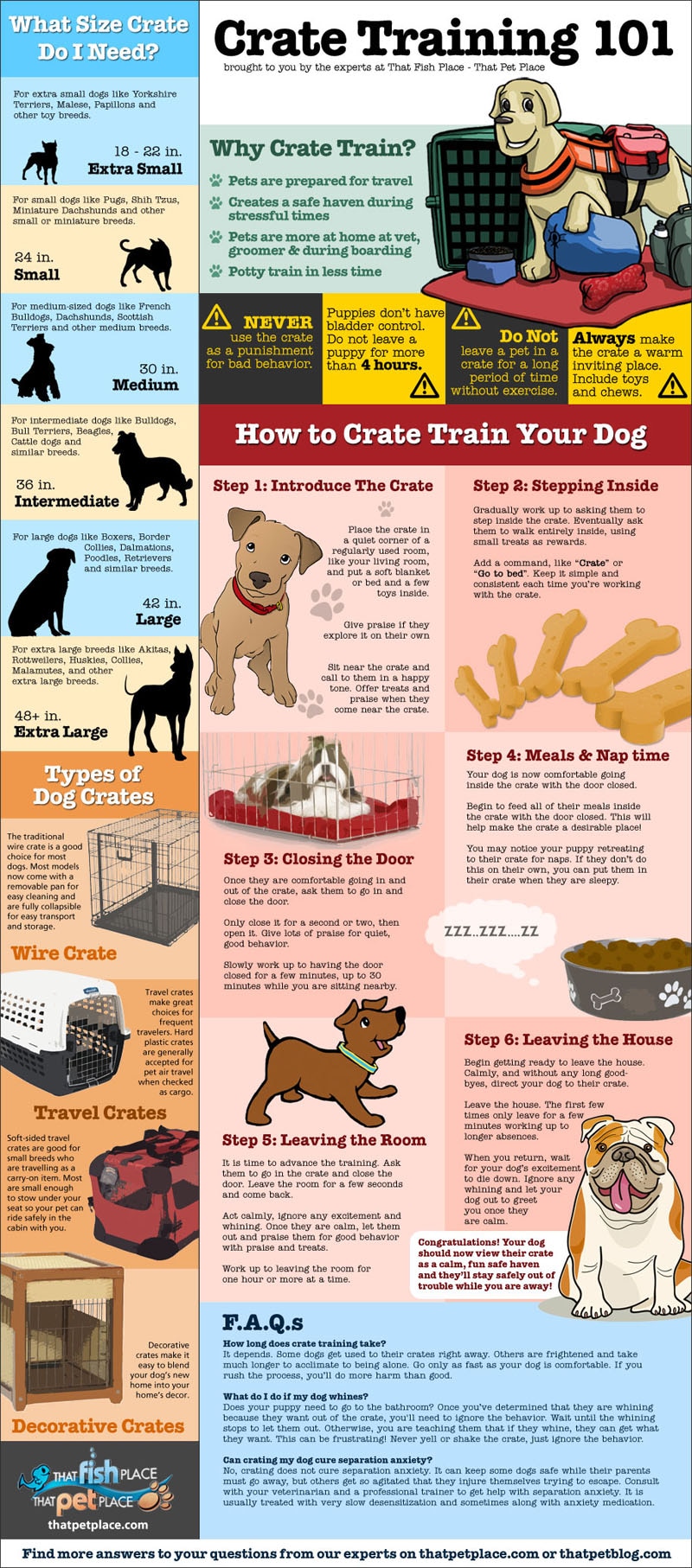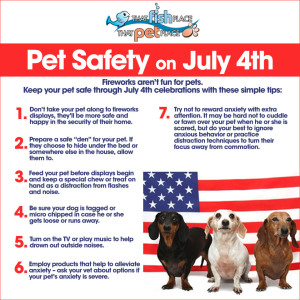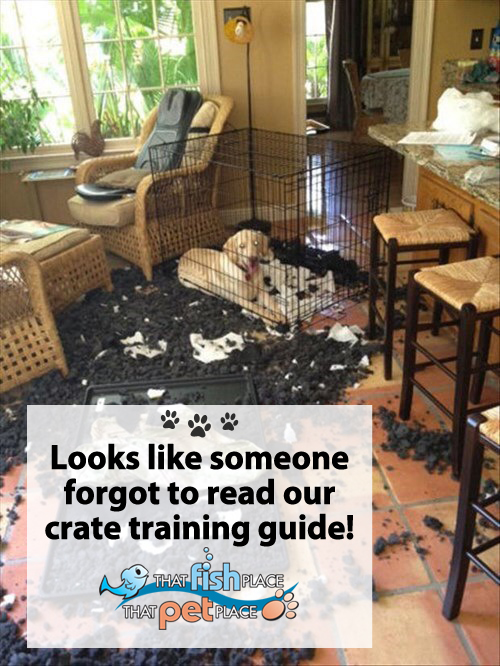You know that feeling you get every time you see a new dog? That somewhat uncontrollable urge to run over scoop that pup up and snuggle it for hours. As tempting as it may be, think about it from the dog’s point of view, scary right? If a dog sees you as a threat they may feel like they have no choice other than to bite. Here are some tips on how to greet dogs in a non-threatening manner.
Category Archives: Crate Training
Feed SubscriptionJuly 4th Fun & Fireworks – Pet Anxiety & Safety Tips
The July 4th Holiday is upon us, and unfortunately it is one of the busiest times for animal shelters due to the overwhelming amount of dogs lost during the fireworks & festivities. The fireworks may be fun for us, for some of our canine friends it can be downright terrifying.
During fireworks displays, or even while setting off fireworks in your backyard and neighborhood, your usually calm family pet may become extremely stressed. The stress overload can cause some pets to try to escape the house or yard. By following a few simple tips for this holiday weekend you can avoid coming home to an empty house and the anxiety of a missing beloved family pet.
- Avoid bringing your pet to fireworks displays, even if they are not usually startled by loud noises or thunder.
- Keep your pet indoors in a quiet, safe, sheltered area. Keep doors and windows closed and locked (I’ve heard stories of dogs opening slider doors or even jumping through windows to escape). Leave the TV on or play soothing music at a normal level to distract him from the noise outside
- Prepare a safe “den” for your pet. If they choose to hide under the bed, in their crate or somewhere else in the house, allow them to. If your dog is not crate trained, and you would like him to be please visit our comprehensive crate training guide.
- Feed your pet before the displays begin and keep a special chew treat on hand as a distraction.
- Nervous or stressed dogs may chew to ease anxiety. Make sure to provide proper chew toys and make sure all cords and other dangerous objects are out of reach
- Try a calming aid to help calm anxiety, or ask your vet for medication to help with your pet’s noise phobia.
- Do not leave your pet outside during the festivities. Even with a fence or a tie-out a dog can go to great lengths to escape the source of their anxiety.
- Always make sure your pet is wearing a properly fitted dog collar with up-to-date ID tags. Consider having your pet microchipped for extra security.
- Try not to reward anxiety with extra attention. It may be hard not to cuddle or fawn over your pet when he is scared, but do your best to ignore axious behavior or practice distraction techniques to turn their focus away from commotions.
Follow these simple steps to enjoy a worry free Independence Day. The knowledge that your family pets are safe and sound will make your holiday all the more fun. Have a great holiday weekend!
Severe Weather can also be very stressful on our pets. Check out this post for tips on keeping you pets calm during severe weather.
Top Five DOs and DON’Ts of Crate Training
Welcome back, Pet Blog Readers! I’ve missed you!
We’ve been spending a lot of time focused on crate training and how to crate train your dog recently. Why have we been so focused on it? Crate training, if that is the route you are planning to go, is a long process and you must have dedication and commitment and stick to the training in order for it to work properly. You don’t want your dog to dread the crate – you want them to love it and look forward to their alone time or a place for solace. The only way that will happen is if you follow our guide and only move at a pace that your dog is comfortable with.
To summarize and simplify our crate training series, I put together my list of the top 5 things you should do when you are crate training and the top 5 things to avoid while crate training. Good luck!
Top 5 “Dos” of Crate Training
- DO exercise your pet before crating
- DO place the crate in a quiet corner of a frequently used room
- DO make their crate comfortable and inviting
- DO provide appropriate toys and treats in the crate [only if your pup can be trusted with toys while unsupervised – use your judgement]
- DO choose a crate that will be the appropriate size when your pup grows up
Top 5 “Don’ts” of Crate Training
- DON’T use the crate for punishment
- DON’T force your dog into the crate
- DON’T leave dogs in the crate for a long periods of time
- DON’T let children or adults tease your crated dog
- DON’T rush the crate training process
If you’re looking for more information on how to crate train your dog, check out my full crate training guide on thatpetplace.com. You’ll find specific details on each step of the crate training process and some of the commonly encountered problems and how to deal with them.
If you’re just starting the crate training process be sure to leave us a comment and let us know if our guides have helped you. We’d also love to know what kinds of problems you’re running into while trying to crate train your dog. Leave us a comment and we will consult with our experts to try to come up with a solution to help.
Read More »
Top 3 Crate Training Questions, Answered
 Continuing our series on crate training, this segment will answer some of the top questions we get when people are considering crate training their dogs or puppies. Our previous posts included why you should consider crate training and the three main steps for crate training your dog. Hopefully by now you know that crate trained dogs don’t view their crates as punishment, but as a refuge in a world that is constantly changing around them. You also know that crate training can be a slow process. That leads us to our first question:
Continuing our series on crate training, this segment will answer some of the top questions we get when people are considering crate training their dogs or puppies. Our previous posts included why you should consider crate training and the three main steps for crate training your dog. Hopefully by now you know that crate trained dogs don’t view their crates as punishment, but as a refuge in a world that is constantly changing around them. You also know that crate training can be a slow process. That leads us to our first question:
How Long Will Crate Training Take?
The answer to this very common question is “It depends.” It depends on your dog’s age, temperament, personality, and any past experiences they may have had in a crate.
It is very important not to rush the process of crate training. Take your time and only proceed when your dog is comfortable with the last step in the training process. If you move too fast, your dog may become anxious or fearful of the crate. The purpose of your dog’s crate is to provide a safe, comfortable environment where your dog can retreat to if they are anxious, scared, or there is too much excitement in the house.
The crate should always be a safe, welcoming and enjoyable environment, which is why you should never use the crate as a tool for punishing bad behavior. Make sure to provide plenty of treats, praise, fun toys, and love while you are crate training. Your dog will learn to enjoy time in the crate and will begin to use it on his own, without you asking him to go to his crate.
The second most common question we hear has to do with whining. Many puppies have this issue in particular and it can be heart wrenching to listen to. Lets talk about some steps to try if your dog is whining while they are inside their crate.
What do I do if my dog is whining?
You never want to let your dog out of the crate when they are whining. This only serves as a “reward” and they’ve now learned that whining will get them out of the crate. Consider first that your puppy may be whining because he needs to go to the bathroom. Calmly take him straight outside to do his business and return him to the crate without any stops along the way.
Read More »
3 Simple Steps to Crate Train Your Dog
 Crate training your dog may seem like a daunting task. In our last post of this series we discussed the benefits associated with crate training. This time we’ll focus on simplifying the crate training process into three easy steps that anyone can follow. You, too can have a successfully crate trained dog who is happy to sleep in their crate and retreat there when life becomes hectic!
Crate training your dog may seem like a daunting task. In our last post of this series we discussed the benefits associated with crate training. This time we’ll focus on simplifying the crate training process into three easy steps that anyone can follow. You, too can have a successfully crate trained dog who is happy to sleep in their crate and retreat there when life becomes hectic!
After you select your dog crate, the first step is to slowly introduce the new furniture to your dog.
Step 1: Introduce the crate
• Select your location and put a soft blanket or crate pad in the crate. Add a few favorite toys and chews. Please note: do not provide chews and toys if you dog is a heavy chewer or is not trusted with chews while unsupervised. Some dogs can destroy toys or chews and suffer from impactions or choke on the pieces.
• If your dog begins investigating the crate on his own, provide plenty of praise and treats for going near or in the crate on his own. You’ll want to stock up on training treats for this process!
• If he does not come to investigate on his own, sit by the crate and talk to him in soft, soothing tones. Call him over to you. Remember to give treats and praise each time he comes near the crate.
• Once he is comfortable being around the crate, begin to toss small treats just inside the door. Praise him each time he goes in to retrieve the treat.
• Eventually toss the treats farther back until he goes the whole way inside the crate. Lots of praise and love during this step. This is the part that may take the longest. Remember never to force him into the crate. You want him to choose to enter the crate on his own.
The key that many people disregard is that crate training does not happen overnight. Depending on your individual dog, this process could take weeks. You want to take it slow and only proceed once your dog is 100% comfortable with the previous step. If they begin to show reluctance or are clearly uncomfortable, slow your pace down and return to the previous step. Read More »
Why Should I Crate Train My Dog?
 Crate training can be a challenge for many pet parents. The first thing I often hear is that they feel bad leaving them in a crate while they are away instead of letting them have a place to roam and sleep on the couch. Crate training doesn’t have to be a negative thing, in fact, it should be your pet’s favorite place to be… that is if you’ve done your crate training the right way. This is the first of a series of posts about crate training, so lets start with the simplest question to answer: why should I crate train my puppy? P.S. if you can’t wait for the rest of the series of articles, I’ve written a comprehensive guide on crate training available on thatpetplace.com.
Crate training can be a challenge for many pet parents. The first thing I often hear is that they feel bad leaving them in a crate while they are away instead of letting them have a place to roam and sleep on the couch. Crate training doesn’t have to be a negative thing, in fact, it should be your pet’s favorite place to be… that is if you’ve done your crate training the right way. This is the first of a series of posts about crate training, so lets start with the simplest question to answer: why should I crate train my puppy? P.S. if you can’t wait for the rest of the series of articles, I’ve written a comprehensive guide on crate training available on thatpetplace.com.
Does my dog need a crate?
Lets go back to a time before dogs evolved into, well, domesticated dogs. Wild dogs, foxes and wolves all have a den in the wild. They are all relatives and in the wild have many of the same behaviors. A den acts as a dog’s safe haven. It is a place to retreat to when they are frightened, feel threatened, where they go to eat, and where they raise their young.
In your home your pet’s crate becomes their den. If you follow the right steps the crate becomes your pet’s safe haven, retreat and home within their home. Scared of thunderstorms? Lay in the crate and feel comforted. Too busy in the house with guests? Retreat to the crate for some rest and relaxation. Fearful that your sister is going to steal your bone? Take it into your crate and feel safe. You can see where I am going, right?
Read More »
 That Pet Blog That Pet Place Pet Blog
That Pet Blog That Pet Place Pet Blog



